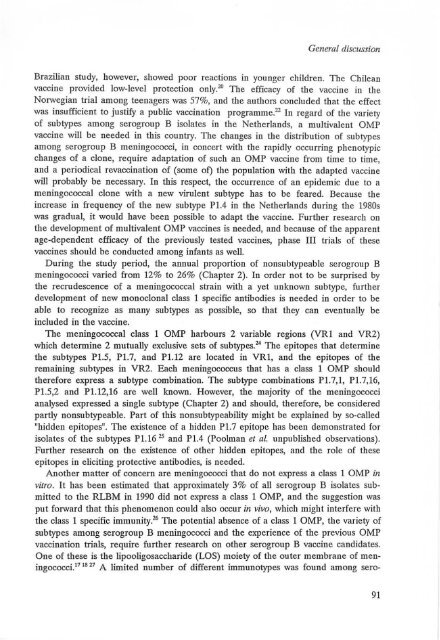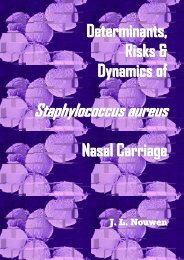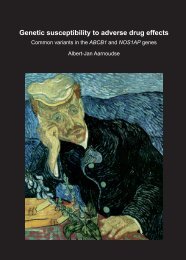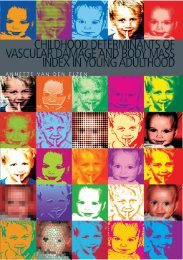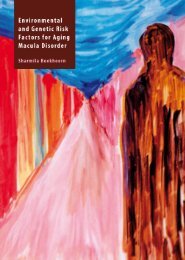An attempt at an epidemiological explanation - Epib.nl
An attempt at an epidemiological explanation - Epib.nl
An attempt at an epidemiological explanation - Epib.nl
- No tags were found...
You also want an ePaper? Increase the reach of your titles
YUMPU automatically turns print PDFs into web optimized ePapers that Google loves.
General discussionBrazili<strong>an</strong> study, however, showed poor reactions in younger children. The Chile<strong>an</strong>vaccine provided low-level protection o<strong>nl</strong>y.20 The efficacy of the vaccine in theNorwegi<strong>an</strong> trial among teenagers was 57%, <strong>an</strong>d the authors concluded th<strong>at</strong> the effectwas insufficient to justify a public vaccin<strong>at</strong>ion prograrnme. 22 In regard of the varietyof subtypes among serogroup B isol<strong>at</strong>es in the Netherl<strong>an</strong>ds, a multivalent OMPvaccine will be needed in this country. The cb<strong>an</strong>ges in the distribution of sub typesamong serogroup B meningococci, in concert with the rapidly occurring phenotypicch<strong>an</strong>ges of a clone, require adapt<strong>at</strong>ion of such <strong>an</strong> OMP vaccine from time to time,<strong>an</strong>d a periodical revaccin<strong>at</strong>ion of (some of) the popul<strong>at</strong>ion with the adapted vaccinewill probably be necessary. In this respect, the occurrence of <strong>an</strong> epidemic due to ameningococcal clone with a new virulent subtype bas to be feared. Because theincrease in frequency of the new subtype P1.4 in the Netherl<strong>an</strong>ds during the 1980swas gradual, it would have been possible to adapt the vaccine. Further research onth e development of multivalent OMP vaccines is needed, <strong>an</strong>d because of the apparentage-dependent efficacy of the previously tested vaccines, phase III trials of thesevaccines should be conducted among inf<strong>an</strong>ts as well.During tbe study period, the <strong>an</strong>nual proportion of nonsubtypeable serogroup Bmeningococci varied from 12% to 26% (Cbapter 2). In order not to be surprised bythe recrudescence of a meningococcal strain with a yet unknown subtype, furtherdevelopment of new monoclonal class 1 specific <strong>an</strong>tibodies is needed in order to beable to recognize as m<strong>an</strong>y subtypes as possible, so th<strong>at</strong> they c<strong>an</strong> eventually beincluded in the vaccine.The meningococcal class 1 OMP harbours 2 variable regions (VRI <strong>an</strong>d VR2)wbich determine 2 mutually exclusive sets of subtypes." The epitopes th<strong>at</strong> determinethe subtypes P1.5, P1.7, <strong>an</strong>d P1.l2 are loc<strong>at</strong>ed in VRl, <strong>an</strong>d the epitopes of tberemaining subtypes in VR2. Each meningococcus th<strong>at</strong> has a class 1 OMP sbouldtherefore express a subtype combin<strong>at</strong>ion. 111e subtype combin<strong>at</strong>ions P1.7,1, P1.7,16,P1.5,2 <strong>an</strong>d Pl.12,16 are well known. However, the majority of the meningococci<strong>an</strong>alysed expressed a single subtype (Chapter 2) <strong>an</strong>d sbould, therefore, be consideredpartly nonsubtypeable. Part of this nonsubtypeability might be explained by so-called"hidden epitopes". The existence of a hidden P1.7 epitope has been demonstr<strong>at</strong>ed forisol<strong>at</strong>es of the sub types Pl.16 25 <strong>an</strong>d Pl.4 (Poolm<strong>an</strong> et af. unpublished observ<strong>at</strong>ions).Furtber research on the existence of other hidden epitopes, <strong>an</strong>d the role of theseepitopes in eliciting protective <strong>an</strong>tibodies, is needed.<strong>An</strong>other m<strong>at</strong>ter of concern are meningococci th<strong>at</strong> do not express a class 1 OMP invitro. It has been estim<strong>at</strong>ed th<strong>at</strong> approxim<strong>at</strong>ely 3% of all serogroup B isol<strong>at</strong>es submittedto the RLBM in 1990 did not express a class 1 OMP, <strong>an</strong>d the suggestion wasput forward th<strong>at</strong> this phenomenon could also occur in vivo, which might interfere withthe class 1 specific immunity." The potential absence of a class 1 OMP, tbe variety ofsubtypes among serogroup B meningococci <strong>an</strong>d the experience of the previous OMPvaccin<strong>at</strong>ion trials, require further research on other serogroup B vaccine c<strong>an</strong>did<strong>at</strong>es.One of tbese is the lipooligosaccbaride (LOS) moiety of tbe outer membr<strong>an</strong>e of meningococci.17 18 27 A limited number of different immunotypes was found among sero-91


